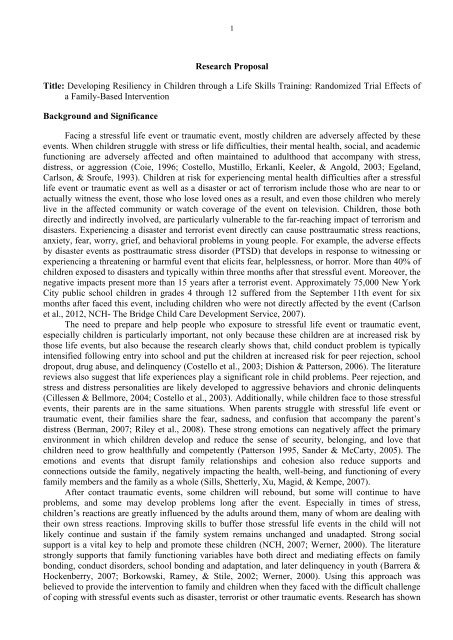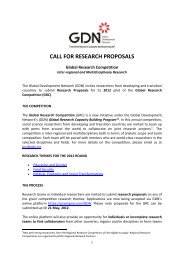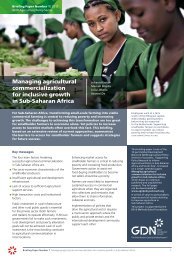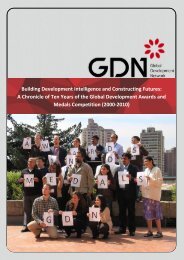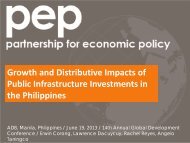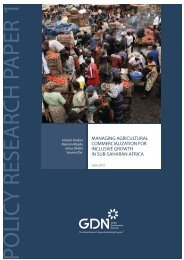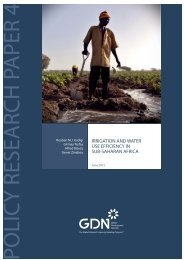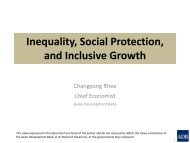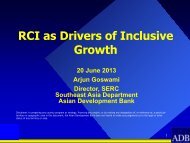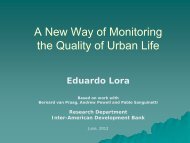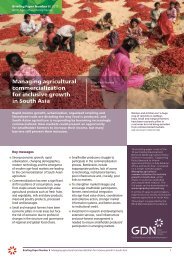Developing Resiliency in Children through a Life Skills Training
Developing Resiliency in Children through a Life Skills Training
Developing Resiliency in Children through a Life Skills Training
- No tags were found...
Create successful ePaper yourself
Turn your PDF publications into a flip-book with our unique Google optimized e-Paper software.
1Research ProposalTitle: <strong>Develop<strong>in</strong>g</strong> <strong>Resiliency</strong> <strong>in</strong> <strong>Children</strong> <strong>through</strong> a <strong>Life</strong> <strong>Skills</strong> Tra<strong>in</strong><strong>in</strong>g: Randomized Trial Effects ofa Family-Based InterventionBackground and SignificanceFac<strong>in</strong>g a stressful life event or traumatic event, mostly children are adversely affected by theseevents. When children struggle with stress or life difficulties, their mental health, social, and academicfunction<strong>in</strong>g are adversely affected and often ma<strong>in</strong>ta<strong>in</strong>ed to adulthood that accompany with stress,distress, or aggression (Coie, 1996; Costello, Mustillo, Erkanli, Keeler, & Angold, 2003; Egeland,Carlson, & Sroufe, 1993). <strong>Children</strong> at risk for experienc<strong>in</strong>g mental health difficulties after a stressfullife event or traumatic event as well as a disaster or act of terrorism <strong>in</strong>clude those who are near to oractually witness the event, those who lose loved ones as a result, and even those children who merelylive <strong>in</strong> the affected community or watch coverage of the event on television. <strong>Children</strong>, those bothdirectly and <strong>in</strong>directly <strong>in</strong>volved, are particularly vulnerable to the far-reach<strong>in</strong>g impact of terrorism anddisasters. Experienc<strong>in</strong>g a disaster and terrorist event directly can cause posttraumatic stress reactions,anxiety, fear, worry, grief, and behavioral problems <strong>in</strong> young people. For example, the adverse effectsby disaster events as posttraumatic stress disorder (PTSD) that develops <strong>in</strong> response to witness<strong>in</strong>g orexperienc<strong>in</strong>g a threaten<strong>in</strong>g or harmful event that elicits fear, helplessness, or horror. More than 40% ofchildren exposed to disasters and typically with<strong>in</strong> three months after that stressful event. Moreover, thenegative impacts present more than 15 years after a terrorist event. Approximately 75,000 New YorkCity public school children <strong>in</strong> grades 4 <strong>through</strong> 12 suffered from the September 11th event for sixmonths after faced this event, <strong>in</strong>clud<strong>in</strong>g children who were not directly affected by the event (Carlsonet al., 2012, NCH- The Bridge Child Care Development Service, 2007).The need to prepare and help people who exposure to stressful life event or traumatic event,especially children is particularly important, not only because these children are at <strong>in</strong>creased risk bythose life events, but also because the research clearly shows that, child conduct problem is typically<strong>in</strong>tensified follow<strong>in</strong>g entry <strong>in</strong>to school and put the children at <strong>in</strong>creased risk for peer rejection, schooldropout, drug abuse, and del<strong>in</strong>quency (Costello et al., 2003; Dishion & Patterson, 2006). The literaturereviews also suggest that life experiences play a significant role <strong>in</strong> child problems. Peer rejection, andstress and distress personalities are likely developed to aggressive behaviors and chronic del<strong>in</strong>quents(Cillessen & Bellmore, 2004; Costello et al., 2003). Additionally, while children face to those stressfulevents, their parents are <strong>in</strong> the same situations. When parents struggle with stressful life event ortraumatic event, their families share the fear, sadness, and confusion that accompany the parent’sdistress (Berman, 2007; Riley et al., 2008). These strong emotions can negatively affect the primaryenvironment <strong>in</strong> which children develop and reduce the sense of security, belong<strong>in</strong>g, and love thatchildren need to grow healthfully and competently (Patterson 1995, Sander & McCarty, 2005). Theemotions and events that disrupt family relationships and cohesion also reduce supports andconnections outside the family, negatively impact<strong>in</strong>g the health, well-be<strong>in</strong>g, and function<strong>in</strong>g of everyfamily members and the family as a whole (Sills, Shetterly, Xu, Magid, & Kempe, 2007).After contact traumatic events, some children will rebound, but some will cont<strong>in</strong>ue to haveproblems, and some may develop problems long after the event. Especially <strong>in</strong> times of stress,children’s reactions are greatly <strong>in</strong>fluenced by the adults around them, many of whom are deal<strong>in</strong>g withtheir own stress reactions. Improv<strong>in</strong>g skills to buffer those stressful life events <strong>in</strong> the child will notlikely cont<strong>in</strong>ue and susta<strong>in</strong> if the family system rema<strong>in</strong>s unchanged and unadapted. Strong socialsupport is a vital key to help and promote these children (NCH, 2007; Werner, 2000). The literaturestrongly supports that family function<strong>in</strong>g variables have both direct and mediat<strong>in</strong>g effects on familybond<strong>in</strong>g, conduct disorders, school bond<strong>in</strong>g and adaptation, and later del<strong>in</strong>quency <strong>in</strong> youth (Barrera &Hockenberry, 2007; Borkowski, Ramey, & Stile, 2002; Werner, 2000). Us<strong>in</strong>g this approach wasbelieved to provide the <strong>in</strong>tervention to family and children when they faced with the difficult challengeof cop<strong>in</strong>g with stressful events such as disaster, terrorist or other traumatic events. Research has shown
2that <strong>in</strong>terventions focus<strong>in</strong>g on improv<strong>in</strong>g family communication of pro-social and healthy values andexpectations, resiliency, and child protective factors (Kumpfer & Tait, 2000; McCart, Priester, HobartDavies, & Azen, 2006). In addition, parent participation <strong>in</strong> preventive program is seen to be helpful tochildren and school, and be the mediat<strong>in</strong>g effect of life skills resources because parents are a powerful<strong>in</strong>fluence on cultivat<strong>in</strong>g child value and behaviors (Kumpfer & Tait, 2000; Patterson, 1995). Especiallychildren learn those all from their parents to develop social skills and cope with life's challenges(Bandura, 1986; Bigner, 2006).<strong>Resiliency</strong> is the appropriate personality as strength and positive adaptation that help a person orfamily cope with stress or life difficulties, <strong>in</strong>creas<strong>in</strong>g the likelihood of rebound from difficult situations(Kirby & Fraser, 1997). The resilient children exhibit <strong>in</strong> their cop<strong>in</strong>g and development of competence<strong>in</strong> the face of challenges. Resilient children are notably different from non-resilient children <strong>in</strong> terms ofhav<strong>in</strong>g greater problem-solv<strong>in</strong>g, cop<strong>in</strong>g with stress, self-regulatory skill, and self-esteem, as well as <strong>in</strong>receiv<strong>in</strong>g more active parental monitor<strong>in</strong>g (Berman, 2007; Gilligan, 1999). <strong>Life</strong> skills tra<strong>in</strong><strong>in</strong>g is usedto help children not only acquire knowledge, but also develop relevant skills to enable them to reducethe risk of behaviors and negative consequences (Botv<strong>in</strong> & Griff<strong>in</strong>, 2004). This skills tra<strong>in</strong><strong>in</strong>g is one ofthe best alternative strategies for the proper practice <strong>in</strong> essential abilities for manag<strong>in</strong>g child life,particularly decision-mak<strong>in</strong>g and critical th<strong>in</strong>k<strong>in</strong>g ability by consider<strong>in</strong>g <strong>in</strong>formation and behaviorconsequences, and ability <strong>in</strong> recognition of strong feel<strong>in</strong>gs <strong>in</strong> one’s self and others to modulate one’sown behavioral response, resolve disagreements, and follow rules <strong>in</strong> a productive and healthy manner(WHO, 2003).This present study aims to exam<strong>in</strong>e the effectiveness of the <strong>in</strong>tervention program that is speciallydesigned to develop child life skills <strong>in</strong>tended to develop resiliency by us<strong>in</strong>g parent tra<strong>in</strong><strong>in</strong>g comb<strong>in</strong>ewith child life skills tra<strong>in</strong><strong>in</strong>g <strong>through</strong> the implementation of a theoretically based <strong>in</strong>tervention us<strong>in</strong>g anexperimental study design. The children will be tra<strong>in</strong>ed to develop beliefs, attitude and behaviors, anddirectly practice to be the resilient children, whereas their parents will be taught about the risk andprotective factors for resiliency and tra<strong>in</strong>ed for develop<strong>in</strong>g resilience <strong>in</strong> their child. Repeated measuresanalyses of variance will be used to test the primary outcome as children’s resiliency and a ma<strong>in</strong>ta<strong>in</strong>edoutcome across time by group. Comparison between the experimental (child tra<strong>in</strong><strong>in</strong>g and parenttra<strong>in</strong><strong>in</strong>g) and control (children and parents do not receive tra<strong>in</strong><strong>in</strong>g) groups will be conductedimmediately after the <strong>in</strong>tervention and at the 2 nd month after the completion of the <strong>in</strong>tervention.PurposesThe purpose of the study is to exam<strong>in</strong>e the effect of the life skills tra<strong>in</strong><strong>in</strong>g program focused onresiliency on the resilience of children at immediately after the <strong>in</strong>tervention and at the second monthfollow-up after the implementation of the <strong>in</strong>tervention.Research questions1. What is the effect of the life skills tra<strong>in</strong><strong>in</strong>g program focused on resiliency on the resilience ofchildren?2. Does the resilience of children significantly change across the two time periods atimmediately after the <strong>in</strong>tervention and at the second month after the <strong>in</strong>terventions?Theoretical frameworkThe conceptual framework of this study is derived from social cognitive theory (Bandura, 1986)which views the importance of the family as the major environment of their children <strong>in</strong> the process ofobservational learn<strong>in</strong>g and role models. Modified behavior is a result of cognitive, environmental, andbehavioral <strong>in</strong>fluences, is considered to use <strong>in</strong> both child life skills tra<strong>in</strong><strong>in</strong>g and parents tra<strong>in</strong><strong>in</strong>g (Botv<strong>in</strong>& Griff<strong>in</strong>, 2004; WHO, 2003). The process of child life skill development based on Bandura’s social
3cognitive theory focus on the socialization environment produced by the family and parents thatviewed as the major environment of their children. The most important issue of this perspective is thatthere are three determ<strong>in</strong>ants of <strong>in</strong>dividual behavior which demonstrate <strong>through</strong> the reciprocalrelationship and <strong>in</strong>fluence of the <strong>in</strong>dividual and their environment.Behavioral FactorsCognitive and PersonalFactorsEnvironmentalFactorsFigure 1 Triadic reciprocal determ<strong>in</strong>ism (Bandura, 1986)Moreover, the concept of resilience provides a useful lens for view<strong>in</strong>g established conceptualframework and key developmental research. The model presented <strong>in</strong> this paper is based on an analysisof the resilience literature and Bandura’s social cognitive theory, and is organized <strong>in</strong> relation to thosethree key concepts: (1) resilience as a process <strong>in</strong>fluenced by culture, <strong>in</strong>dividual attributes, and lifechanges; (2) the family as the context of development; and (3) potential environmental supports for thedevelopment of resilience housed <strong>in</strong> societal <strong>in</strong>stitutions, friendship networks, and the extended family.The conceptual framework of this study is shown <strong>in</strong> Figure 2.The <strong>Life</strong> <strong>Skills</strong> Tra<strong>in</strong><strong>in</strong>g<strong>Children</strong>Family Context- Parental Stressors- Communication- Parental support- Parent<strong>in</strong>g Quality- <strong>Resiliency</strong> and Traumatic <strong>Life</strong>- Self-esteem- Decision-mak<strong>in</strong>g andProblem-solv<strong>in</strong>g skills- Cop<strong>in</strong>g with stress skill- Critical th<strong>in</strong>k<strong>in</strong>g skill- Self-regulatory skillThe Parent Tra<strong>in</strong><strong>in</strong>g- <strong>Resiliency</strong> and Traumatic <strong>Life</strong>- Self-esteem- Decision-mak<strong>in</strong>g andProblem-solv<strong>in</strong>g skills- Cop<strong>in</strong>g with stress skill- Critical th<strong>in</strong>k<strong>in</strong>g skill- Self-regulatory skill<strong>Children</strong> Resilient<strong>Skills</strong>- Self-esteem- Decision-mak<strong>in</strong>g andProblem-solv<strong>in</strong>g skills- Cop<strong>in</strong>g with stress skill- Critical th<strong>in</strong>k<strong>in</strong>g skill- Self-regulatory skillResilient childrenFigure 2 The conceptual framework
4Literature ReviewsResilience: The literature conta<strong>in</strong>s various def<strong>in</strong>itions of resilience. Some studies have def<strong>in</strong>edresilience as the ability of an entity to recover or bounce back from the adverse effects of a natural ormanmade threat (Egeland at al., 1993; Gilbert, 2010). <strong>Resiliency</strong> is viewed as strengths that help aperson or family cope with stress or life difficulties, <strong>in</strong>creas<strong>in</strong>g the likelihood of rebound from difficultsituations (Kirby & Fraser, 1997).In addition, resilience is used to mean the ability to withstand ahazard without suffer<strong>in</strong>g much harm. Resilience <strong>in</strong> this paper refers to the ability to recover aftersuffer<strong>in</strong>g harm from a hazard, stressful life and traumatic event, and implies both the ability to adjustto normal or anticipated stresses and stra<strong>in</strong>s and to adapt to sudden shocks and extraord<strong>in</strong>ary demands(Gilbert, 2010; NCH, 2007; Tierney, 2003).Literature reviews have <strong>in</strong>dicated that resilience is really about the ability of a person to copewith liv<strong>in</strong>g <strong>in</strong> spite of stresses. Psychologists suggest that the resilience is built on three ma<strong>in</strong> conceptsas follow (Northern Territory Government, 2011): (1) I CAN make a difference. (2) I AM aworthwhile person. (3) I HAVE people around I trust and who love and support me.Furthermore, the essential abilities for develop<strong>in</strong>g resiliency <strong>in</strong> children are decision-mak<strong>in</strong>g andproblem-solv<strong>in</strong>g skills, cop<strong>in</strong>g with stress skill, critical th<strong>in</strong>k<strong>in</strong>g skill, self-regulatory skill, and selfesteemskill (Berman, 2007; Botv<strong>in</strong> & Griff<strong>in</strong>, 2004; Braverman, 2001; Gilligan, 1999; NCH, 2007;WHO, 2003).<strong>Life</strong> skills tra<strong>in</strong><strong>in</strong>g: Over the past thirty years, life skills tra<strong>in</strong><strong>in</strong>g (LST) has been found to producepositive behavioral changes and better skills, especially regard<strong>in</strong>g tak<strong>in</strong>g responsibility for mak<strong>in</strong>ghealthy choices, resist<strong>in</strong>g negative pressures, and avoid<strong>in</strong>g risky behaviors (Botv<strong>in</strong> & Griff<strong>in</strong>, 2004;WHO, 2003). <strong>Life</strong> skills are cognitive, emotional, <strong>in</strong>terpersonal and social skills that enable<strong>in</strong>dividuals to deal effectively with the challenges of everyday life. The World Health Organization(WHO) has recommended that LST programs, for children, <strong>in</strong>clude content address<strong>in</strong>g: decisionmak<strong>in</strong>g; problem solv<strong>in</strong>g; critical and creative th<strong>in</strong>k<strong>in</strong>g; <strong>in</strong>terpersonal relationship skills; selfawareness;empathy; cop<strong>in</strong>g with emotions and stress; and, effective communication (Botv<strong>in</strong> &Griff<strong>in</strong>, 2004).Prior research, consistently, has shown that LST programs have a positive effect on preventionof risky health practices (i.e., dr<strong>in</strong>k<strong>in</strong>g, smok<strong>in</strong>g, abus<strong>in</strong>g drugs, and engag<strong>in</strong>g <strong>in</strong> unprotected sex)(Cook, Gresham, Kern, Barreras, & Crews, 2008). With regard to the statistical effectiveness of LSTprograms, the results of meta-analyses have shown effect sizes rang<strong>in</strong>g from 0.28 to 0.32 (Cook et al.,2008; Wilson, Gottfredson, & Najaka, 2001). In addition, prior research has found the effectiveness ofLST programs, for children, to be positively <strong>in</strong>fluenced when parents are <strong>in</strong>cluded. When a familyfocusedapproach is used <strong>in</strong> a LST program, child behavioral problems are reduced, on average, n<strong>in</strong>etimes more than when solely child-focused approaches are used (McCart et al., 2006). Thus, <strong>in</strong> order to<strong>in</strong>crease the effectiveness of develop<strong>in</strong>g and chang<strong>in</strong>g child behaviors, most LST program developersare comb<strong>in</strong><strong>in</strong>g parent tra<strong>in</strong><strong>in</strong>g with child skills tra<strong>in</strong><strong>in</strong>g.Parent tra<strong>in</strong><strong>in</strong>g programs: Over the past two decades, when parent tra<strong>in</strong><strong>in</strong>g has been <strong>in</strong>cluded as partof risk prevention programs for children, the tra<strong>in</strong><strong>in</strong>g has addressed parents’ ability to practice soundchild-rear<strong>in</strong>g skills (i.e., parent-child communication, support, model<strong>in</strong>g, monitor<strong>in</strong>g, supervis<strong>in</strong>g, andstress and cop<strong>in</strong>g management), as well as consciously th<strong>in</strong>k about their children’s development(Bigner, 2006; Davis, Day, & Bidmead, 2002). Unfortunately, few studies, conducted <strong>in</strong> Asiancountries have <strong>in</strong>cluded parent participation <strong>in</strong> their child life skills development programs,particularly those <strong>in</strong> Thailand. Preventive <strong>in</strong>terventions that emphasize parent participation have notbeen widely utilized because of the widespread belief that it is impossible to get parents to participate(The Family Network Foundation, 2008).
5MethodologyDesign: The randomized controlled trial design is planned to provide the best possible evidenceto resilience development <strong>in</strong> children.Ethical Considerations: Approval to conduct the study will be granted by the Research EthicsReview Committee of the primary <strong>in</strong>vestigator’s (PI) <strong>in</strong>stitution and the directors of the schools usedas research sett<strong>in</strong>gs. All potential participants and their parents will be <strong>in</strong>formed about the study’spurposes, the <strong>in</strong>tervention program, confidentiality and anonymity issues, and potential risks andbenefits. They also are expla<strong>in</strong>ed what their voluntary participation will entail; they could withdrawwithout repercussion. All of the potential subjects and their parents that consent to participate will beasked to sign an assent or a consent form.Sett<strong>in</strong>g: The study will be conducted at the sample schools <strong>in</strong> Prathumthani prov<strong>in</strong>ce that is thedisaster area from big crisis flood <strong>in</strong> the last year. Prior to randomiz<strong>in</strong>g, via lot draw<strong>in</strong>g will be usedeach school’s and student’s identification number.Sample: The target populations <strong>in</strong> this study are school-age children who can read and writeThai language (grades 4 th -6 th ) and their parents who are liv<strong>in</strong>g <strong>in</strong> disaster-urban area <strong>in</strong> order tounderstand and appropriately participate <strong>in</strong> the program. The sampl<strong>in</strong>g elementary School wasrandomly selected via draw<strong>in</strong>g lots method by the researcher.The approximate sample size for the s<strong>in</strong>gle group repeated measures design wasdeterm<strong>in</strong>ed based on statistical power analysis, at a significance level of .05, a desired power of .80,and the average correlation of the subjects’ responses to the number of repeated measures (Stevens,2009). The sample size for the s<strong>in</strong>gle group repeated measures design is be at least 82 subjects pergroup. The attrition rate (20% of the sample size) will be added to each group. The study then has toenroll at least 98 participants per group.The PI will contact the sampl<strong>in</strong>g school for collaboration and to build relationships. Theresearcher and research team will meet with the school adm<strong>in</strong>istration committee, parent-teacherassociation, and school health team for provid<strong>in</strong>g <strong>in</strong>formation about <strong>in</strong>tervention and data collectionand facilitat<strong>in</strong>g the <strong>in</strong>tervention <strong>in</strong> June 2013. After ga<strong>in</strong><strong>in</strong>g permission from the school and approvalfrom the Committee on Human Rights Related to Research Involv<strong>in</strong>g Human Subjects, ThammasatUniversity, data collect<strong>in</strong>g processes will be employed from July to September 2013.Data will be collected from all participants, particularly the students. The basel<strong>in</strong>eassessments were completed with both experimental and control groups before implementation. Theparents will be randomly assigned to the experimental group or control group, us<strong>in</strong>g lots (number ofparents) draw<strong>in</strong>g by the research assistants. The students will be also recruited correspond<strong>in</strong>gly theirparents. Then, the participant who met the <strong>in</strong>clusion criteria will be <strong>in</strong>vited to the study. Theparticipants who are will<strong>in</strong>g to participate will be recruited for <strong>in</strong>tervention. The post-test data will becollected at immediately after the <strong>in</strong>tervention and at the second month follow-up after theimplementation of the <strong>in</strong>tervention.Instrument: Data will be obta<strong>in</strong>ed from each subject via use of the Proactive Cop<strong>in</strong>g Inventory(PCI-Thai version). The questionnaires consist of the Demographic Data Questionnaire (DDQ) and theProactive Cop<strong>in</strong>g Inventory (PCI). The PI develop the DDQ <strong>in</strong> order to obta<strong>in</strong> <strong>in</strong>formation for eachparticipant on the follow<strong>in</strong>g age, gender, religion, parents’ education, parents’ occupation, and familymonthly <strong>in</strong>come.The Proactive Cop<strong>in</strong>g Inventory (PCI), orig<strong>in</strong>ally developed by Greenglass, Schwarzer, andTaubert and Thai translated by Oraphan Tatha, Puchong Laorujisawat, and Esther Greenglass (Tatha,Laorujisawat, & Greenglass, 2012), consisted of 55 items that assessed proactive cop<strong>in</strong>g 14 items,reflective cop<strong>in</strong>g 11 items, strategic plann<strong>in</strong>g 4 items, preventive cop<strong>in</strong>g 10 items, <strong>in</strong>strumental supportseek<strong>in</strong>g 8 items, emotional support seek<strong>in</strong>g 5 items, and avoidance cop<strong>in</strong>g 3 items. The Cronbach’salpha, for this portion of the questionnaire, ranged between 0.70- 0.81.
6Intervention: Two <strong>in</strong>terventions were used <strong>in</strong> this study. These <strong>in</strong>terventions <strong>in</strong>cluded a: <strong>Life</strong><strong>Skills</strong> Tra<strong>in</strong><strong>in</strong>g Program focused on <strong>Resiliency</strong> (LST-R), for the children <strong>in</strong> experimental and ParentTra<strong>in</strong><strong>in</strong>g Program for <strong>Develop<strong>in</strong>g</strong> Resilient <strong>Children</strong> (PTP-RC), for the parents <strong>in</strong> the experimentalgroup.1. The <strong>Life</strong> <strong>Skills</strong> Tra<strong>in</strong><strong>in</strong>g Program focused on <strong>Resiliency</strong> (LST-R), developed by the PI,focused on provid<strong>in</strong>g <strong>in</strong>formation about and promot<strong>in</strong>g the resiliency development <strong>in</strong> children. Thecontent validity of the program will be exam<strong>in</strong>ed by three experts (i.e., two nurs<strong>in</strong>g faculty membersand one educator with experience and skills <strong>in</strong> child cognitive behavioral strategies).2. The Parent Tra<strong>in</strong><strong>in</strong>g Program for <strong>Develop<strong>in</strong>g</strong> Resilient <strong>Children</strong> (PTP-RC), developed by thePI, focused on promot<strong>in</strong>g and provid<strong>in</strong>g <strong>in</strong>formation on parent<strong>in</strong>g skills and resiliency developmentneeded for support<strong>in</strong>g the resiliency development <strong>in</strong> children. The PTP-RC will be reviewed forcontent validity by three experts (i.e., two nurs<strong>in</strong>g faculty members and one educator with cl<strong>in</strong>icalexperience and skills <strong>in</strong> family-child nurs<strong>in</strong>g care and family counsel<strong>in</strong>g).Data Analysis: Descriptive statistics will be used to analyze the participants’ demographiccharacteristics. Chi-square and <strong>in</strong>dependent t-test will be used to evaluate differences, between theexperimental and control groups. Analysis of covariance and repeated measures ANOVA will beemployed to test change, over time, <strong>in</strong> each group, and the difference between groups, with theexception of the demographic variables. Additionally, the standardized difference between means willbe calculated to determ<strong>in</strong>e the effect size of treatment or the magnitude of the treatment effect. A smalleffect size is def<strong>in</strong>ed as 0.20, a moderate effect size as 0.50, and a large effect size as 0.80.Research Team with Brief CVs : Number of Members: 1Project Leader:Name: __Institution: Faculty of Nurs<strong>in</strong>g, Thammasat UniversityCurrent Position: Assistant ProfessorHighest Educ. Atta<strong>in</strong>ment: Doctor of Philosophy (Nurs<strong>in</strong>g)Nationality: ThaiGender: FemaleAge: 45 years oldTra<strong>in</strong><strong>in</strong>g/Visit<strong>in</strong>g: Parent Advisor Tra<strong>in</strong><strong>in</strong>g Course (15 credits), Florence Night<strong>in</strong>gale School ofNurs<strong>in</strong>g & Midwifery, K<strong>in</strong>g’s College London, University of London, UK (2010)Publication:___., Phuphaibul, R., Suwonnaroop, N.,Villarruel, A.M., & Nityasuddhi, D. (2013). The effect of aparent tra<strong>in</strong><strong>in</strong>g program, <strong>in</strong> conjunction with a life skills tra<strong>in</strong><strong>in</strong>g program for school-agechildren, on children’s life skills, and parents’ child-rear<strong>in</strong>g skills and perceptions of supportfor child life skills development. Pacific Rim International Nurs<strong>in</strong>g Research, 17(1), 3-27.
7Project ScheduleProject ScheduleActivity- Literature Reviews and IRBApproval- Prepare and develop research<strong>in</strong>struments and research assistantsTime Period (2013)May June July August September OctoberNovember-December- Implement the <strong>in</strong>tervention- Collect and Analyze data- F<strong>in</strong>al report and prepare manuscript- PublicationTotal Budget (USD): US$ 10,5001. Honorarium for two research assistants $ 3,000($ 300 x 5 months x 2 persons)2. Payment for parents <strong>in</strong> experimental group’s <strong>in</strong>centive $1,000($10x100 persons)3. Payment for parents <strong>in</strong> control group’s <strong>in</strong>centive $500($5x100 persons)4. Payment for <strong>in</strong>struments’ validators $1,0005. Payment for collect<strong>in</strong>g and analysis data $5006. Material used <strong>in</strong> two <strong>in</strong>terventions $1,0007. Pr<strong>in</strong>t<strong>in</strong>g/photocopy $1,0008. Transportation $1,0009. Food and dr<strong>in</strong>k for implementation and collect<strong>in</strong>g data $1,00010. Postage and mail/mobile phone $500…………………………………………………………………………………..
8ReferenceBandura, A. (1986). Social foundations of thought and action: A social cognitive theory. EnglewoodCliffs, New Jersey: Prentice-Hall.Barrera, P., & Hockenberry, M.J. (2007). Family <strong>in</strong>fluences on child health promotion. In M.J.Hockenberry and D. Wilson. (Eds.), Wong’s nurs<strong>in</strong>g care of <strong>in</strong>fants and children (pp. 55-91).(8 th ed.). St. Louis, Missouri: Mosby.Berman, Y. (2007). Foster<strong>in</strong>g resilience among children <strong>in</strong> difficult life circumstances. Retrieved April5, 2012 from http://www.euro.centre.org/data/1181826911_17191.pdf.Bigner, J.J. (2006). Parent<strong>in</strong>g school-age children. In J.J. Bigner. (Ed.), Parent-Child Relations: AnIntroduction to Parent<strong>in</strong>g (pp. 176-182). New York: Pearson Prentice HallBraverman, M.T. (2001). Apply<strong>in</strong>g resilience theory to the prevention of adolescent substance abuse.Retrieved April 5, 2012 from http://www.ca4h.org/files/1232.pdf.Borkowski, J.G., Ramey, S.L. & Stile, C. (2002). Parent<strong>in</strong>g research: Translation to parent<strong>in</strong>gpractices. In J.G. Borkowski, S.L. Ramey, and M. Bristol-Power (Eds.), Parent<strong>in</strong>g and theChild’s World: Influences on Academic, Intellectual, and Social-Emotional Development (pp.365-386). New Jersey: Lawrence Erlbaum Associates.Botv<strong>in</strong>, G. J., & Griff<strong>in</strong>, K.W. (2004). <strong>Life</strong> skills tra<strong>in</strong><strong>in</strong>g: Empirical f<strong>in</strong>d<strong>in</strong>gs and future directions.The Journal of Primary Prevention, 25(2), 211-232.Carlson, L., Bassett, G., Buehr<strong>in</strong>g, W., Coll<strong>in</strong>s, M., Folga, S., Haffenden, B., et al. (2012). Resilience:Theory and applications. Retrieved April 5, 2012 from http:// www.dis.anl.gov/pubs/72218.pdf.Cillessen, A.H.N. & Bellmore, A.D. (2004). Social skills and <strong>in</strong>terpersonal perception <strong>in</strong> early andmiddle. In P.K. Smith and C.H. Hart (Eds.), Childhood Social Development (pp. 355-374).Oxford: Blackwell Publish<strong>in</strong>g.Coie, J.D. (1996). Prevention of violence and antisocial behavior. In R.D. Peters and R.J. McMahon(Eds.), Prevent<strong>in</strong>g Childhood Disorders, Substance Abuse, and Del<strong>in</strong>quency (pp. 1-18).California: Sage Publication, Inc.Cook, C.R., Gresham, F.M., Kern, L., Barreras, R.B., & Crews, S.D. (2008).Social skills tra<strong>in</strong><strong>in</strong>g forsecondary students with emotional and /or behavioral disorders: A review and analysis of themeta-analytic literature. Journal of Emotional and Behavioral Disorders, 16(3), 131-144.Costello, J. E., Mustillo, S., Erkanli, A., Keeler, G., & Angold, A. (2003). Prevalence and developmentof psychiatric disorders <strong>in</strong> childhood and adolescence. Archives of General Psychiatry, 60, 837–844.Davis, H., Day, C., & Bidmead, C. (2002). Parent<strong>in</strong>g toddlers and young children. In H. Davis, C.Day, and C. Bidmead (Eds.), Work<strong>in</strong>g <strong>in</strong> partnership with parent: The parent adviser model (pp.218-248). London: Harcourt Assessment.Dishion, T.J., & Patterson, G.R. (2006). The development and ecology of antisocial behavior <strong>in</strong>children and adolescent. In D. Cicchetti & D.J. Cohen (Eds.), Developmental psychopathologyVolume 3: Risk, disorder, and adaptation (pp. 503-541). New York: Wiley.Egeland, B., Carlson, E., & Sroufe, L. A. (1993). Resilience as a process. Development andPsychopathology, 58, 517–528.Gilbert, S.W., 2010, Disaster Resilience: A Guide to the Literature, U.S. Department of Commerce,National Institute of Standards and Technology, NIST Special Publication 1117.
9Greenberg, M. T., Weissberg, R. P., Utne, M., Z<strong>in</strong>s, J. E., Fredericks, L., Resnik, H., et al. (2003).Enhanc<strong>in</strong>g school-based prevention and youth development <strong>through</strong> coord<strong>in</strong>ated social,emotional, and academic learn<strong>in</strong>g. American Psychologist, 58, 466–474.Kirby, L. D. & Fraser, M. W. (1997). Risk and resiliency <strong>in</strong> childhood. In Fraser, M. W. (Ed.), Riskand <strong>Resiliency</strong> (pp. 10-33). Wash<strong>in</strong>gton, DC: NASW Press.Kumpfer, K.L., & Tait, C.M. (2000). Family skills tra<strong>in</strong><strong>in</strong>g for parents and children. Juvenile JusticeBullet<strong>in</strong> of the office of Juvenile Justice and Del<strong>in</strong>quency Prevention., April, 1-12.McCart, M.R., Priester, P.E., Hobart Davies, W., & Azen, R. (2006). Differential effectiveness ofbehavioral parent-tra<strong>in</strong><strong>in</strong>g and cognitive-behavioral therapy for antisocial youth: A metaanalysis.Journal of Abnormal Child Psychology, 34(4), 527-543.NCH- The Bridge Child Care Development Service. (2007). Literature review: Resilience <strong>in</strong> childrenand young people. Retrieved April 14, 2013 from http://www.actionforchildren.org.uk/.../resilience_<strong>in</strong>_children_<strong>in</strong>.Northern Territory Government. (2011). Cop<strong>in</strong>g skills (resilience). Retrieved April 14, 2013 fromhttp://www.families.nt.gov.auPatterson, J. M. (1995). Promot<strong>in</strong>g resilience <strong>in</strong> families experienc<strong>in</strong>g stress. Pediatric Cl<strong>in</strong>ics of NorthAmerica, 42(1), 47–63.Riley, A.W., Valdez, C.R., Barrueco, S., Mills, C., Beardslee, W., Sandler, I., et al. (2008).Development of a family-based program to reduce risk and promote resilience among familiesaffected by maternal depression: theoretical basis and program description. Cl<strong>in</strong>ical Child andFamily Psychology Review, 11, 12–29.Rose, A. (2009). Economic Resilience to Disasters, CARRI Research Report 8. Retrieved April 17,2013 from http://www.resilientus.org/library/Research_Report_8_Rose_1258138606.pdf.Sander, J. B., & McCarty, C. A. (2005). Youth depression <strong>in</strong> the family context: Familial risk factorsand models of treatment. Cl<strong>in</strong>ical Child and Family Psychology Review, 8(3), 203–219.Sills, M. R., Shetterly, S., Xu, S., Magid, D., & Kempe, A. (2007). Association between parentaldepression and children’s health care use. Pediatrics, 119(4), 829–836.Stevens, J. (2009). Applied multivariate statistics for the social sciences. (5th ed.). New York:Routledge Taylor & Francis Group.Tatha, O., Laorujisawat, P., & Greenglass, E. (2012). The validity and reliability of the proactivecop<strong>in</strong>g <strong>in</strong>ventory (PCI): Thai version (Thai). Retrieved April 5, 2012, from http://www.psych.yorku.ca/.../PCI-Thai-Version-as-of-Mar-12-2013.pdf.The Family Network Foundation. (2008). The strengthen<strong>in</strong>g Thai family project (Thai). Retrieved June12, 2009, from http://www. familynetworkfoundation.orgTierney, K. (2003). Conceptualis<strong>in</strong>g and Measur<strong>in</strong>g Organizational and Community Resilience:Lessons from the Emergency Response Follow<strong>in</strong>g the September 11, 2001 Attack on the WorldTrade Center, Prelim<strong>in</strong>ary paper 329. Newark: University of Delaware.Werner, E.E. (2000). Protective factors and <strong>in</strong>dividual resilience. In J.P. Shonkoff & S.J. Meisels(eds.), Handbook of early childhood <strong>in</strong>tervention (2nd ed., pp. 115-132). NY: Cambridge.Wilson, D.B., Gottfredson, D.C., & Najaka, S.S. (2001). School-Based Prevention of ProblemBehaviors: A meta-analysis. Journal of Quantitative Crim<strong>in</strong>ology, 17(3), 247-272.World Health Organization. (2003). <strong>Skills</strong> for health skills-based health education <strong>in</strong>clud<strong>in</strong>g life skills:An important component of a child-friendly/health-promot<strong>in</strong>g school. Retrieved November 29,2008, from http://www.who. <strong>in</strong>t/school-youth_health/media/en/sch_<strong>Skills</strong>4health-03.pdf
10SummaryTitle: <strong>Develop<strong>in</strong>g</strong> <strong>Resiliency</strong> <strong>in</strong> <strong>Children</strong> <strong>through</strong> a <strong>Life</strong> <strong>Skills</strong> Tra<strong>in</strong><strong>in</strong>g: Randomized Trial Effects ofa Family-Based InterventionBackground and SignificanceFac<strong>in</strong>g a stressful life event or traumatic event, mostly children are adversely affected by theseevents. When children struggle with stress or life difficulties, their mental health, social, and academicfunction<strong>in</strong>g are adversely affected and often ma<strong>in</strong>ta<strong>in</strong>ed to adulthood that accompany with stress,distress, or aggression (Coie, 1996; Costello, Mustillo, Erkanli, Keeler, & Angold, 2003; Egeland,Carlson, & Sroufe, 1993). Improv<strong>in</strong>g skills to buffer those stressful life events <strong>in</strong> the child will notlikely cont<strong>in</strong>ue and susta<strong>in</strong> if the family system rema<strong>in</strong>s unchanged and unadapted. Us<strong>in</strong>g thisapproach was believed to provide the <strong>in</strong>tervention to family and children when they faced with thedifficult challenge of cop<strong>in</strong>g with stressful events such as disaster, terrorist or other traumatic events.Little is known about family-based prevention programs for develop<strong>in</strong>g resilient children <strong>in</strong>Thailand, there are sizeable gaps <strong>in</strong> the effectiveness of the family-based <strong>in</strong>tervention <strong>in</strong> assess<strong>in</strong>g thevalue of resilience development <strong>in</strong> children or not. The program <strong>in</strong>terventions <strong>in</strong> this study consist ofthe life skills tra<strong>in</strong><strong>in</strong>g program focused on resiliency and the parent tra<strong>in</strong><strong>in</strong>g program for develop<strong>in</strong>gresilient children. Those two programs aim to develop resiliency <strong>in</strong> children.Purposes: The purpose is to exam<strong>in</strong>e the effect of the life skills tra<strong>in</strong><strong>in</strong>g program focused on resiliencyon the resilience of children at immediately after the <strong>in</strong>tervention and at the second month follow-upafter the implementation of the <strong>in</strong>tervention.Research questions1. What is the effect of the life skills tra<strong>in</strong><strong>in</strong>g program focused on resiliency on the resilience ofchildren?2. Does the resilience of children significantly change across the two time periods atimmediately after the <strong>in</strong>tervention and at the second month after the <strong>in</strong>terventions?Design: The randomized controlled trial design.Ethical Considerations: Approval to conduct the study will be granted by the Research EthicsReview Committee of the primary <strong>in</strong>vestigator’s (PI) <strong>in</strong>stitution and the directors of the schools usedas research sett<strong>in</strong>gs.Sample: Approximately 98 school-age children who can read and write Thai language (grades 4 th -6 th )and their parents live <strong>in</strong> disaster-urban area, <strong>in</strong>clud<strong>in</strong>g Prathumtani Prov<strong>in</strong>ce.Instrument: The Proactive Cop<strong>in</strong>g Inventory (PCI-Thai version) will be used to obta<strong>in</strong> data.Intervention: Two <strong>in</strong>terventions were used <strong>in</strong> this study. These <strong>in</strong>terventions <strong>in</strong>cluded a: <strong>Life</strong> <strong>Skills</strong>Tra<strong>in</strong><strong>in</strong>g Program focused on <strong>Resiliency</strong> (LST-R), for the children <strong>in</strong> experimental and Parent Tra<strong>in</strong><strong>in</strong>gProgram for <strong>Develop<strong>in</strong>g</strong> Resilient <strong>Children</strong> (PTP-RC), for the parents <strong>in</strong> the experimental group.Data Analysis: Descriptive statistics, Chi-square, <strong>in</strong>dependent t-test, analysis of covariance, andrepeated measures ANOVA will be used to test change, over time, <strong>in</strong> each group, and the differencebetween groups with the exception of the demographic variables. Additionally, the effect size oftreatment will be calculated to determ<strong>in</strong>e the magnitude of the treatment effect.Total Budget (USD): US $ 10,500Project Duration (months): 6 months (May-October 2013)Research Team (the number of member = 1)Project Leader: __Faculty of Nurs<strong>in</strong>g, Thammasat University, ThailandE-mail: __
11Regional Research Competition 2013Toward a More Resilient SocietyApplication Cover PageRESEARCH PROPOSALProject Title: <strong>Develop<strong>in</strong>g</strong> <strong>Resiliency</strong> <strong>in</strong> <strong>Children</strong> <strong>through</strong> a <strong>Life</strong> <strong>Skills</strong> Tra<strong>in</strong><strong>in</strong>g: Randomized TrialEffects of a family-based Intervention.Total Budget (USD): US $ 10,500Project Duration (months): 6 monthsRESEARCH TEAMNo. of Members: 1Project Leader:Name: __Institution: Faculty of Nurs<strong>in</strong>g, Thammasat UniversityCurrent Position: Assistant ProfessorHighest Educ. Atta<strong>in</strong>ment: Doctor of Philosophy (Nurs<strong>in</strong>g)Nationality: ThaiGender: FemaleAge: 45 years oldMail<strong>in</strong>g Address: 99 M.18 Faculty of Nurs<strong>in</strong>g, Thammasat University (Piyachat Build<strong>in</strong>g),Paholyoth<strong>in</strong> Road, Khlong Luang, Prathumthani, Thailand, 12121E-mail: __Phone (<strong>in</strong>cl country+area codes): 66-02-9869213 ext. 7383Mobile (<strong>in</strong>cl country+area codes): 66-081-6186001Fax (<strong>in</strong>cl country+area codes): 66-02-5165381


